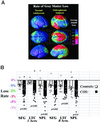Mapping adolescent brain change reveals dynamic wave of accelerated gray matter loss in very early-onset schizophrenia
- PMID: 11573002
- PMCID: PMC58784
- DOI: 10.1073/pnas.201243998
Mapping adolescent brain change reveals dynamic wave of accelerated gray matter loss in very early-onset schizophrenia
Abstract
Neurodevelopmental models for the pathology of schizophrenia propose both polygenetic and environmental risks, as well as early (pre/perinatal) and late (usually adolescent) developmental brain abnormalities. With the use of brain mapping algorithms, we detected striking anatomical profiles of accelerated gray matter loss in very early-onset schizophrenia; surprisingly, deficits moved in a dynamic pattern, enveloping increasing amounts of cortex throughout adolescence. Early-onset patients were rescanned prospectively with MRI, at 2-year intervals at three time points, to uncover the dynamics and timing of disease progression during adolescence. The earliest deficits were found in parietal brain regions, supporting visuospatial and associative thinking, where adult deficits are known to be mediated by environmental (nongenetic) factors. Over 5 years, these deficits progressed anteriorly into temporal lobes, engulfing sensorimotor and dorsolateral prefrontal cortices, and frontal eye fields. These emerging patterns correlated with psychotic symptom severity and mirrored the neuromotor, auditory, visual search, and frontal executive impairments in the disease. In temporal regions, gray matter loss was completely absent early in the disease but became pervasive later. Only the latest changes included dorsolateral prefrontal cortex and superior temporal gyri, deficit regions found consistently in adult studies. These emerging dynamic patterns were (i) controlled for medication and IQ effects, (ii) replicated in independent groups of males and females, and (iii) charted in individuals and groups. The resulting mapping strategy reveals a shifting pattern of tissue loss in schizophrenia. Aspects of the anatomy and dynamics of disease are uncovered, in a changing profile that implicates genetic and nongenetic patterns of deficits.
Figures






References
-
- Jacobsen L K, Rapoport J L. J Child Psychol Psychiatry. 1998;39:101–113. - PubMed
-
- Feinberg I. J Psychiatr Res. 1982;17:319–334. - PubMed
-
- Weinberger D R. In: Schizophrenia. Hirsch S R, Weinberger D R, editors. London: Blackwood; 1995. pp. 294–323.
-
- McGlashan T H, Hoffman R E. Arch Gen Psychiatry. 2000;57:637–648. - PubMed
Publication types
MeSH terms
Grants and funding
LinkOut - more resources
Full Text Sources
Other Literature Sources
Medical

